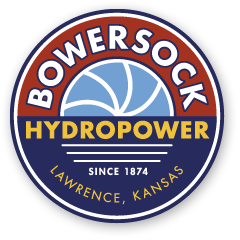Why is the City of Lawrence responsible for maintenance on the Bowersock Dam?
Really, the costs of the maintenance are shared. Historically, the City has paid for the major maintenance projects, but Bowersock has paid for any improvements that are specifically for the benefit of power production. For example, Bowersock paid for a significant dam repair in the mid 1980’s to build up the center portion of the dam because it made it easier for Bowersock to raise the flashboards. Since this didn’t directly benefit the City, Bowersock paid the costs. Likewise, Bowersock paid to install the Obermeyer Gates. Even though the gates help keep the mill pond at a steady level, Bowersock felt that the benefit was primarily Bowersock’s, so BMPC paid the costs of that installation and the rehabilitation that went along with it. On a daily basis, Bowersock provides the labor to construct, install, raise, and maintain the flashboards that put the mill pond at the appropriate height for City water intakes. Since 1977, BMPC has supported approximately 46% of all costs to maintain the dam and preserve the millpond level at flashboard height of 812’ MSL. Absent the BMPC partnership, in order to maintain the Dam, the City would have to shoulder the entire cost burden. Undoubtedly, BMPC is able to maintain the flashboards in a raised position for significantly less than it could be done by the City. If the City did not pay for the major maintenance projects on the dam, Bowersock would not be able to remain in operation. At that point FERC would either require BMPC to decommission the dam, or the City would have to purchase it and take over full maintenance costs. Lawrence would need to expect an increase in dam maintenance expenses of more than 100% in order to keep the millpond at the appropriate level for the full operation of the Kaw River Water Treatment Plant. Based on the cost share alone, the BMPC/Lawrence Partnership is a valuable public/private partnership, providing mutual benefit for both Bowersock and the City of Lawrence.
Who benefits from the Bowersock Mill Pond?
The Bowersock Dam Performs Key Functions for the City of Lawrence and Other Stakeholders
- City of Lawrence Water Supply
The millpond formed by the Bowersock Dam provides a pool for the Kaw River Water Treatment Plant, which supplies approximately 50% of the City water supply on a daily basis.- Optimum operation of the Kaw Plant takes place when the water is at flashboard height of 812’ MSL. The Kaw intakes are operable at dam top height of 808’ MSL, but it is less efficient and requires additional energy. Below 808’ MSL, operations are significantly impacted.
- If the dam were removed, the Kaw Plant and intakes as currently structured would become inoperable, as the Kansas River at Lawrence would become a braided stream at most water levels, in particular in the low water summer months. Expansion of the Wakarusa Plant allows the City to meet most, but not all, City demand at peak times.
- In 2001, the City of Lawrence studied options for providing an alternate method of water extraction (an alluvial well system), and the cost was found to be prohibitive.
- Kansas Department of Transportation (KDOT) Infrastructure
The KDOT bridges immediately upstream of the dam depend on the maintenance of the existing dam structure in order to maintain their structural integrity. KDOT has requested that the dam not be removed in order to protect existing bridge structures. - University of Kansas – Boathouse
The University of Kansas recently completed a $6 M boathouse which relies on the Bowersock Millpond with the flashboards up for appropriate water depths. - Westar Energy – Lawrence Energy Center
Bowersock experience as well as a formal study completed by Olsson Associates indicates that the Westar Energy Center relies on the Bowersock Millpond in order to maintain appropriate water depths to draw water through its intakes at the Lawrence Energy Center (LEC). Although Westar has formally said that the Bowersock Millpond is “inconsequential” to the Westar LEC intakes, BMPC has concerns that removal of the Bowersock Dam and the severe streambed degradation that would accompany the removal of the dam will significantly impact the operations of the Westar LEC. - The Bowersock Mills and Power CompanyBMPC depends on the Bowersock Dam for the production of a maximum of 7 MW of electricity on a daily basis. BMPC produces clean, renewable energy with zero carbon impacts. It is a stated goal of the State of Kansas and the United States Department of Energy to increase the production of renewable, non-polluting, domestic energy supplies in Kansas and for the United States.
